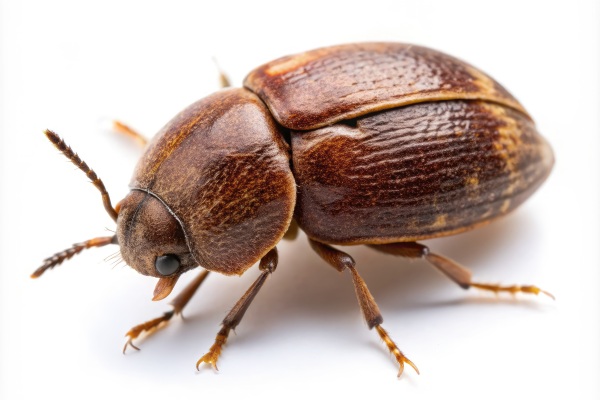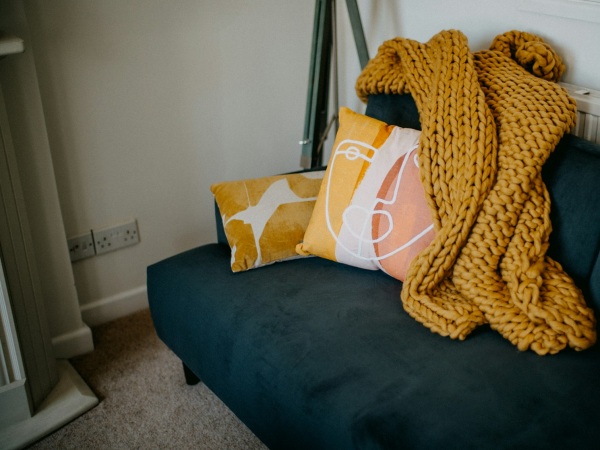When it comes to household pests carpet beetles are hardly ever discussed. But they should be. If more homeowners knew about these insidious little bugs they could take steps to keep them at bay that would save them a lot of headaches. In this post, the carpet cleaning experts at Steve's Carpet Care will attempt to fill the information void when it comes to carpet beetles and provide tips on how to identify and eradicate them.
First Things First: What Are Carpet Beetles?
Carpet beetles are tiny insects - typically about 3mm long - that are native to the outdoors. They are, however, opportunistic and will take advantage of open windows and doors to make their way into homes where they feed on carpets, clothing, drapery and other textiles. Once they settle into your carpets they lay eggs that will use the carpeting as a food source when they hatch. If the problem is not addressed carpet beetles can spread beyond the carpeting to your furniture upholstery, drapery and even into your closets where they'll feast on your favorite outfits.

Why Do I Have Carpet Beetles?
Even if you do an outstanding job keeping your Arvada home in tip-top shape you could still wind up with carpet beetles. That's because whether or not a home has carpet beetles has nothing to do with how often you engage in rug cleaning or air duct cleaning. They can make their way into your house on plants or flowers, on clothes that were hung outside to dry, or they may simply float in through an open window. While they may be found in drapery or clothes they seem to prefer carpeting since it provides an almost endless food supply and countless places for them to hide.
Carpet Beetle Infestation Risks

Carpet beetle infestations may seem small at first, but they can lead to several serious issues for your home and health. Below are some of the potential consequences if an infestation is left untreated:
- Health Risks from Allergens: The bristly hairs of carpet beetle larvae can cause skin irritation, rashes, and allergic reactions. Breathing in their discarded skins can also aggravate respiratory conditions, such as asthma.
- Spread to Other Areas: Carpet beetles are not confined to carpets. They can infest furniture, curtains, bedding, and even stored clothes, spreading the problem throughout your home.
- Long-Term Damage to Belongings: If left unchecked, carpet beetles can cause long-term damage to your clothing, furniture, and heirloom textiles, leading to the need for costly cleaning or replacement.
In conclusion, a carpet beetle infestation can affect both the structural integrity of your home and your health. Regular cleaning and prompt action are key to preventing and minimizing these risks.
Signs That You Have Carpet Beetles
If you see any of the following signs it may indicate the presence of carpet beetles.

- Damage to carpets, upholstery or other textiles — If you notice damage to your carpeting, drapery, upholstery and clothes there's something else going on beside moths. That something else is probably carpet beetles. Most of the damage inflicted by carpet beetles is done by the larvae which feed voraciously on natural fibers. The damage they cause tends to take on a pattern of bald patches of a few square inches each. Depending on where these patches are they may be easy to spot. However, if the damage occurs to areas at the edge of the carpet or under furniture it may go unnoticed for long periods of time.
- Holes in your clothing — Carpet beetles do not exclusively munch on carpet fibers. They're almost as happy chewing holes through your clothes as they are making a main course out of your carpet. If you see holes in your sweaters, coats, scarves and socks it might be the result of moths, or it may be the handiwork of carpet beetles. The damage caused by carpet beetles can often be distinguished from that caused by moths by the pattern of the destruction. Moth holes tend to be small and isolated. While carpet beetle holes tend to be large and grouped together in clusters.
- Molting — Carpet beetles molt as they grow. With each molting session, they leave behind a layer of dried-up skin that, while mostly translucent, may take on a yellow or brownish hue. If the molted skin comes in contact with human skin it can cause all types of irritation. And if it is breathed in by humans it may cause severe respiratory distress.
- Fecal matter — Because of their almost non-stop eating carpet beetle larvae tend to leave behind lots of tiny pellets of fecal matter. These are typically about the size of a grain of salt, are dark in color and resemble small specks that might form a line across the carpeting. Even if you don't see any beetles or dried skin or larvae, the presence of this fecal matter is a dead giveaway that carpet beetles have taken up residence in your carpeting.
Can You Prevent Carpet Beetles From Invading?
Because of the sneaky and discreet way they find their way into a house, it can be difficult to institute effective measures when it comes to keeping them out. After all, you can't prevent your home from interacting with the natural world. So even if you tell loved ones not to bring plants or flowers into the house from outside, or you ban drying clothes outside, carpet beetles might still float in on the breeze when you open the door or may be brought into the house on someone else's clothes. The best thing to do is to create an inhospitable environment for carpet beetles by vacuuming often, having your carpets steam cleaned on a regular basis and acting quickly if you do see signs that carpet beetles are present.
Getting Rid of Carpet Beetles
One of the best ways to get rid of carpet beetles and to prevent them from taking hold if a few do find their way into your house is to have your carpets steam cleaned on a regular basis. At Steve's, we use a state-of-the-art truck-mounted steam cleaning machine that penetrates right down to the bottom of the pile and will quickly and effectively eliminate any carpet beetles hiding there.
This type of cleaning is far and away the most effective method of quickly eliminating carpet beetles. And should the rug cleaning process expose damage caused by carpet beetles our carpet repair service will quickly bring your carpet back to life.

Carpet Beetles vs. Bed Bugs
Because we get asked, here are the differences between carpet beetles and bed bugs.
| Characteristic | Carpet Beetles | Bed Bugs |
|---|---|---|
| Color | Brown, black, or white with patterns on wings | Reddish-brown to mahogany, lighter after feeding |
| Shape | Oval-shaped, slightly rounded | Flat, oval-shaped |
| Size | 1/8 to 1/4 inch (3-5 mm) | 1/4 to 3/8 inch (6-9 mm) |
| Flying Ability | Yes, they can fly | No, bed bugs cannot fly |
| Biting | No, they do not bite humans | Yes, they bite humans to feed on blood |
| Sleep/Wake Times | Active mostly during the day, prefer warm environments | Active at night, primarily nocturnal feeders |
| Habitat | Carpet, upholstered furniture, wool, pet hair | Cracks, crevices, and seams in furniture or walls |
Carpet Beetle FAQs
Carpet beetles typically spread throughout the house when their larvae, which are actively feeding, move from one area to another. They can easily travel from carpets to furniture, drapery, and other textiles, often without being noticed. This movement can occur when people walk through affected areas, or when items like clothing or bedding are moved between rooms.
Yes, carpet beetles can affect pets, especially those with fur. Pets can ingest carpet beetle larvae or come into contact with the pests while moving through infested areas. In some cases, pets may develop skin irritation from the larvae’s bristly hairs. It's important to check your pet’s bedding and grooming areas for signs of carpet beetles.
Carpet beetles tend to favor natural fibers like wool, cotton, silk, and leather, but they can also cause damage to synthetic fabrics, particularly if they are mixed with natural fibers. While synthetic materials are not their first choice, carpet beetles will still feed on them if the conditions are right, especially if the synthetic fibers are soiled or have organic matter on them.
Several natural remedies can help deter carpet beetles, such as essential oils. Eucalyptus, lavender, and cedarwood oils are known to repel carpet beetles. You can dilute the oils with water and spray the mixture on infested areas, or place sachets of dried lavender or cedar chips in your closet and carpeted areas. However, these methods may not eliminate a serious infestation and should be used in conjunction with professional cleaning.
The timeline for eradicating carpet beetles depends on the severity of the infestation. If caught early, it can take as little as a few weeks to fully eradicate them with regular vacuuming and professional steam cleaning. However, more severe infestations could take longer to treat and may require multiple visits from pest control experts or carpet cleaning professionals.
Yes, carpet beetles can return if their entry points (such as open windows, cracks in walls, or gaps around doors) are not sealed or if new infested items are brought into the home. Preventive measures like regular cleaning, sealing cracks, and controlling entry points are key to reducing the chances of re-infestation.
No, while carpet beetles are commonly associated with carpets, they can live in any area with natural fibers. They can infest upholstered furniture, clothing, curtains, pet bedding, and even stored items like woolen blankets or clothes in closets. If you have natural fiber textiles in your home, be sure to regularly inspect them for signs of beetles.
Call Steve’s Carpet Care for All Your Carpet Cleaning Needs
Whether you suspect you have carpet beetles or you just want your carpets to look and feel great the team at Steve's is ready to help. We're one of the most experienced carpet cleaning companies in Colorado and are proud of our more than 45 years of service to the people of Arvada. To learn more or to arrange an appointment call us at (303) 530-4900.
